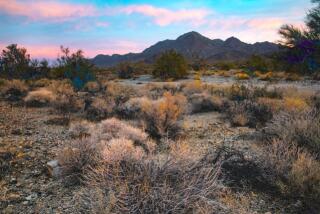Trek in Arizona for the Crater and the Cultures
- Share via
One national monument tells the story of the birth of a mountain; another preserves ancient pueblos and a mosaic of Southwestern cultures. Sunset Crater Volcano and Wupatki national monuments north of Flagstaff are family-friendly wonders--often overlooked, yet well worth a visit.
The parks are connected by the scenic, 36-mile Loop Road, which offers great views of the wide-open Arizona desert. Allow three to four hours to enjoy the drive and hike the trails.
Sunset Crater
Directions to the trail head: From Flagstaff, drive north on U.S. 89 for 12 miles. Take the exit for Sunset Crater Volcano and Wupatki national monuments (Loop Road). Drive two miles east to the visitor center. After viewing excellent exhibits about volcanoes, drive 11/2 miles east on Loop Road to the parking lot for Lava Flow Trail.
The hike: Grand Canyon explorer and U.S. Geological Survey Director John Wesley Powell was quite taken with this strange mountain’s attractive symmetry and color when he visited in the 1890s. “The red cinders seem to be on fire.... The peak seems to glow with a light of its own,” he wrote in “Canyons of the Colorado.” Powell dubbed the volcano Sunset Peak. Unfortunately, the name evolved into Sunset Crater, which has prompted generations of park visitors to look for a hole in the ground rather than a classic cinder-cone volcano.
Sunset Crater is the youngest of more than 400 volcanoes in the San Francisco Mountains of northern Arizona. Experts believe it first blew its top in 1064 or 1065; around 1250, Sunset Crater spewed the last of its cinders, leaving red rock that today calls to mind the colors of sunset.
In 1928, a movie company wanted to dynamite Sunset Crater. The proposal galvanized scientists and local residents, who worked to protect the volcano. The land was declared a national monument in 1930.
Early park visitors climbed the loose sides of the 1,000-foot-tall cone in three-steps-up, two-steps-back fashion. Concerned about erosion and safety, rangers banned climbing in the early 1970s and substituted the mile-long Lava Flow Trail. It loops through the lava field at the base of the crater, which is more than 500 feet deep and measures a mile across. (If your hiking experience isn’t complete without clambering atop a volcano, you can climb other cinder cones, including nearby Lenox Crater. Ask for details at the visitor center.)
Lava Flow Trail passes fumaroles, lava bubbles and clinkers. So vivid are the volcanic features, hikers practically expect lava to ooze down the slopes. Don’t worry: Geologists say an eruption here is highly unlikely.
Wupatki
Directions to the trail head: From Sunset Crater, drive 22 miles north along Loop Road. You can also reach Wupatki from U.S. 89 between Flagstaff and Cameron; from the highway, follow Loop Road 14 miles east to the visitor center.
The hike: Indigenous people fled this area when Sunset Crater began to erupt in the 11th century and earthquakes shook their pit houses. But when the fireworks ceased, a variety of cultures--Sinagua, Cohonina and Anasazi--resettled in the region.
Volcanic ash from Sunset Crater enriched the soil and aided farming in Wupatki Basin. Large pueblos replaced the pit houses and branch shelters.
An interpretive trail extends from the visitor center to the ruins of limestone blocks, sandstone slabs and a clay-based mortar. Wupatki Pueblo (“wupatki” is Hopi for “tall house”) was three stories tall and had about 100 rooms. From a distance, this remarkable structure appears as if it’s still occupied. The design is inspired, from the way water was captured and conserved to the innovative air circulation system constructed for indoor fires.
There’s something profoundly spiritual about these dwellings and their relationship to wind, water, sun and earth. The approach to Wupatki Pueblo is hushed, and many visitors walk the whole trail in contemplative silence.
By the end of the 13th century, the pueblo had been abandoned. Did the water supply dry up? Was there conflict between tribes? Archeologists can only speculate.
*
For more of John McKinney’s tips, visit https://www.thetrailmaster.com.
More to Read
Sign up for The Wild
We’ll help you find the best places to hike, bike and run, as well as the perfect silent spots for meditation and yoga.
You may occasionally receive promotional content from the Los Angeles Times.






